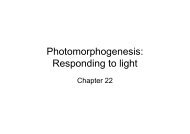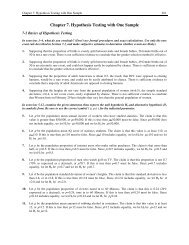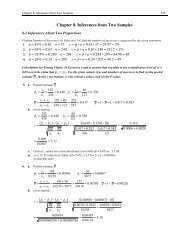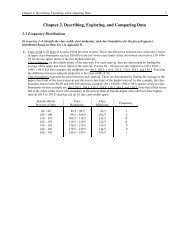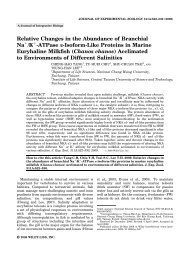Chapter 3. Probability
Chapter 3. Probability
Chapter 3. Probability
You also want an ePaper? Increase the reach of your titles
YUMPU automatically turns print PDFs into web optimized ePapers that Google loves.
74 <strong>Chapter</strong> 3: <strong>Probability</strong>Applying Bayes’ Theorem. In Exercises 21-24, assume that the Altigauge Manufacturing Company makes 80%of all electrocardiograph machines, the Bryant Company makes 15% of them, and the Cardioid Company makesthe other 5%. The electrocardiograph machines made by Altigauge have a 4% rate of defects, the Bryantmachines have a 6% rate of defect, and the Cardioid machines have a 9% rate of defects.We’ll make a table that displays these data had 10000 electrocardiograph machines been made.Altigauge Bryant Cartioid TotalNot DefectiveDefective7680320141090455459545455Total 8000 1500 500 10000number made by Altigaugetotal number made80001000021. a. P(made by Altigauge) = = = 0. 800b. P(Altiguage | defective)number of defective Altigauge electrocardiographsP(Altiguage | defective) =number of defective electrocardiographs320455= 0.703number made by Bryanttotal number made15001000022. a. P(made by Bryant)= = = 0. 150=b. P(Bryant | defective)P(Bryant90455= 0.198| defective)=number of defective Bryant electrocardiographsnumber of defective electrocardiographs=number made by Cardioid 500= =total number made 100002<strong>3.</strong> a. P(made by Cardioid)= 0. 050b. P(Cardioid | defective)P(Cardioid45455= 0.0989| defective)=number of defective Cartioid electrocardiographsnumber of defective electrocardiographs=




